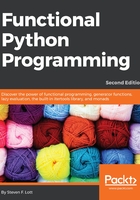
Conventions used
There are a number of text conventions used throughout this book.
CodeInText: Indicates code words in text, database table names, folder names, filenames, file extensions, pathnames, dummy URLs, user input, and Twitter handles. Here is an example: "Python has other statements, such as global or nonlocal, which modify the rules for variables in a particular namespace."
A block of code is set as follows:
s = 0
for n in range(1, 10):
if n % 3 == 0 or n % 5 == 0:
s += n
print(s)
When we wish to draw your attention to a particular part of a code block, the relevant lines or items are set in bold:
s = 0
for n in range(1, 10):
if n % 3 == 0 or n % 5 == 0:
s += n
print(s)
Any command-line input or output is written as follows:
$ pip install pillow beautifulsoup4 PyMonad
Bold: Indicates a new term, an important word, or words that you see onscreen. For example, words in menus or dialog boxes appear in the text like this. Here is an example: "For our purposes, we will distinguish between only two of the many paradigms: functional programming and imperative programming."